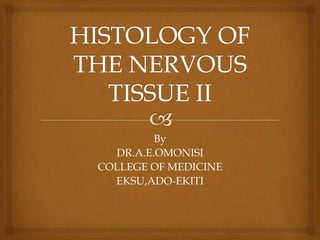
Histology of the Cerebrum, Cerebellum and Brain Stem
- 2. HISTOLOGY OF THE CEREBRUM, CEREBELLUM AND BRAIN STEM
- 3. The central nervous system consists of the brain and the spinal cord. The peripheral nervous system consists of the extensions of neural structures beyond the central nervous system and includes somatic and autonomic divisions. The brain is composed of 3 main structural divisions: the cerebrum, the brainstem, and the cerebellum . At the base of the brain is the brainstem, which extends from the upper cervical spinal cord to the diencephalon of the cerebrum Background
- 4. The brainstem is divided into the medulla, pons, and midbrain. Posterior to the brainstem lies the cerebellum. The cerebrum is the largest component of the brain. It is divided into right and left hemispheres. The corpus callosum is the collection of white matter fibers that joins these hemispheres. Each of the cerebral hemispheres is further divided into 4 lobes: the frontal lobe, the parietal lobe, the temporal lobe, and the occipital lobe. The medial temporal lobe structures are considered by some to be part of the so-called limbic lobe. Background
- 5. Evolutionarily, the brainstem is the most ancient part of the brain. Structurally, it can be divided into the medulla oblongata, pons, and midbrain. Cross-sectional anatomy of the brainstem is rather complex, given the multiple traversing pathways and cranial nerve nuclei . Background
- 6. The cerebellum occupies the posterior fossa, dorsal to the pons and medulla. It is involved primarily in modulating motor control to enable precisely coordinated body movements. Similar to the cerebrum, which has gyri and sulci, the cerebellum has finer folia and fissures that increase the surface area Background
- 7. The cellular structure of the brain is composed primarily of neurons and their support cells, which are broadly termed glial cells. The 3 principal types of glial cells are astrocytes, oligodendrocytes, and microglia. When examined histologically, the neurons of the cortical gray matter demonstrate a laminar pattern. The neocortex contains 6 distinct layers, in contrast to the evolutionarily older paleocortex and archicortex, which typically contain 3 layers. Introduction
- 8. The specific cytoarchitectural patterns of the cortex are not uniform throughout the cerebral cortex, and their variation was mapped by the German physician Korbinian Brodmann and presented in 1909. The so-called Brodmann areas represent cytoarchitectural differences across different brain regions, and the numbering scheme developed by Brodmann is still used to refer to distinct areas of the cortex Introduction
- 9. I: The molecular layer is the outermost layer of the cortex, which lies adjacent to the pial surface II: The external granular layer is a dense layer of primarily inhibitory granule cells; this layer serves mainly to establish intracortical connections III: The external pyramidal layer contains smaller neurons than its deeper counterpart; this layer provides projections to association fibers and commissural fibers. Layers of neocortex
- 11. IV: The internal granular layer is the principal input layer of the cortex, with input derived largely from the thalamus V: The internal pyramidal layer is typically the largest layer within the cortex, containing large pyramidal cells; it is one of the principal output layers of the cortex, projecting to subcortical and spinal pathways; in the motor cortex, cells of this layer are termed Betz cells VI: The fusiform layer contains cells that form association and projection fibers Layers of neocortex
- 16. Cerebellum: Cerebellar cortex: molecular layer: outer stellate cells parallel axons of granule cells (extending from granular layer) Purkinje cell layer: Purkinje Cells: dendrite (multibranched) nucleus axon (difficult to see) axons of deep stellate cells (also called "basket cells"). They lie near but above Purkinje cells. granular layer: granule cells (very numerous) axon of Purkinje cell myelinated fibers of white matter (deep)
- 19. HISTOLOGY OF THE BRAIN STEM
- 20. Brain stem is structurally continuous with the spinal cord. It consists of; – medulla oblangata – pons – mid brain. Background
- 22. The regions of gray and white matter are not clearly separated. The nuclei of the cranial nerves appear as islands surrounded by white matter. Main Histological Features of the Brain stem
- 24. 1. Infection of the CNS & PNS : meningitis, encephalitis & myelitis including poliomyelitis. 2. Trauma to the CNS & PNS. 3. Degeneration and regeneration of nerve tissue. 4. Haemorrhages in the nervous system : epidural, sub-dural , arachnoid , intra-cerebral , pontine and intra-cerebellar haemorrhages. 5. Hydrocephalus 6. Tumours Clinical correlates of nervous tissues
- 25. Central nervous system consists of the cerebrum, cerebellum and spinal cord. The brain has almost no connective tissue and is therefore a relatively soft, gel-like organ. The neocortex is laminated and has six cells layer. The cerebellum has three cells layer. The main components of the peripheral nervous system are nerves, ganglia , and nerve endings. Conclusions
- 26. END